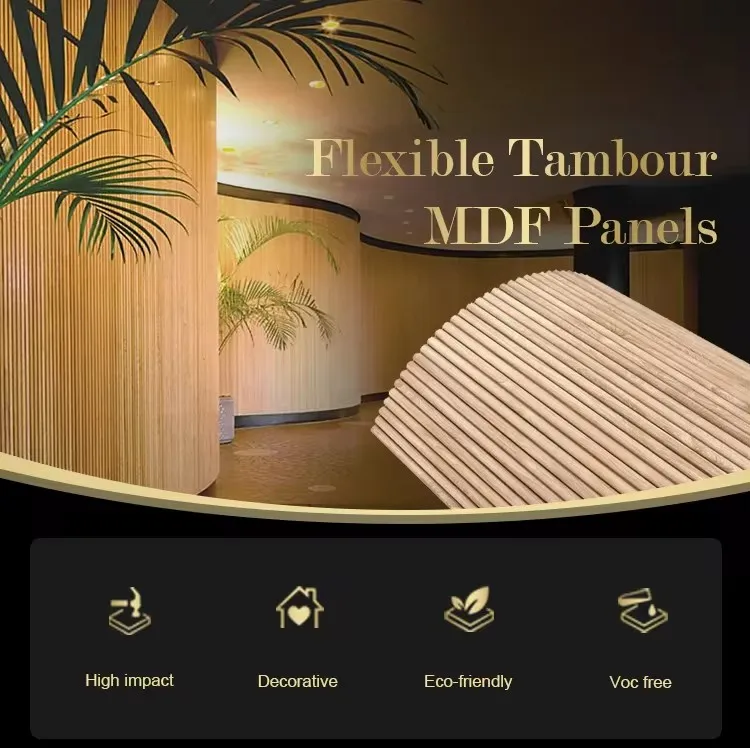Feb . 14, 2025 18:15
Back to list
Grand Wide Light Oak CE FSC Certificate MDF Wooden Veneer Slats Akupanel Acoustic Panels
Decorative acoustic sound panels have revolutionized the way we think about sound management in indoor spaces. More than just a functional addition, these panels have become a critical element in enhancing both the aesthetic appeal and acoustic comfort of homes, offices, and public venues. With an increase in open-plan living and working spaces, managing sound effectively while maintaining an inviting environment is key.
Trustworthiness in the selection of decorative acoustic sound panels is assured through certification and testing standards. Potential buyers should look for panels that meet ASTM International standards for sound absorption (NRC ratings) and fire safety. Manufacturers providing transparent data about their products reinforce consumer confidence and emphasize quality assurance. Real-world applications illustrate the transformative power of decorative acoustic sound panels. Consider a bustling restaurant where patrons often struggle to communicate over the noise. Installing panels not only reduces din but also adds visual flair, enhancing the dining experience and drawing more clientele. Similarly, in educational facilities, well-placed acoustic panels improve speech intelligibility, thus facilitating better learning environments. The evolution in workspace design also embraces biophilic elements, integrating nature into interiors. Acoustic panels now frequently feature natural motifs or materials such as moss and plants, contributing to both wellness and acoustic management. This approach not only amplifies sound control but also boosts mental well-being, thereby increasing productivity and satisfaction in the workplace. Ultimately, choosing the right decorative acoustic sound panels involves a careful balance between aesthetic goals, acoustic needs, and budget considerations. Consulting with interior designers and acoustics professionals ensures that expectations align with the practical capabilities of the panels, providing an authoritative approach to space planning and sound management. Decorative acoustic sound panels are not just a trend but a necessity for modern interiors. They embody the intersection of art and science, offering solutions that enhance aesthetics, functionality, and well-being. As spaces continue to evolve, these panels will undoubtedly remain integral to creating harmonious environments that cater to the acoustic and aesthetic demands of the 21st century.


Trustworthiness in the selection of decorative acoustic sound panels is assured through certification and testing standards. Potential buyers should look for panels that meet ASTM International standards for sound absorption (NRC ratings) and fire safety. Manufacturers providing transparent data about their products reinforce consumer confidence and emphasize quality assurance. Real-world applications illustrate the transformative power of decorative acoustic sound panels. Consider a bustling restaurant where patrons often struggle to communicate over the noise. Installing panels not only reduces din but also adds visual flair, enhancing the dining experience and drawing more clientele. Similarly, in educational facilities, well-placed acoustic panels improve speech intelligibility, thus facilitating better learning environments. The evolution in workspace design also embraces biophilic elements, integrating nature into interiors. Acoustic panels now frequently feature natural motifs or materials such as moss and plants, contributing to both wellness and acoustic management. This approach not only amplifies sound control but also boosts mental well-being, thereby increasing productivity and satisfaction in the workplace. Ultimately, choosing the right decorative acoustic sound panels involves a careful balance between aesthetic goals, acoustic needs, and budget considerations. Consulting with interior designers and acoustics professionals ensures that expectations align with the practical capabilities of the panels, providing an authoritative approach to space planning and sound management. Decorative acoustic sound panels are not just a trend but a necessity for modern interiors. They embody the intersection of art and science, offering solutions that enhance aesthetics, functionality, and well-being. As spaces continue to evolve, these panels will undoubtedly remain integral to creating harmonious environments that cater to the acoustic and aesthetic demands of the 21st century.
